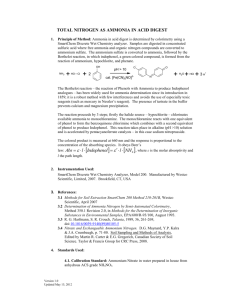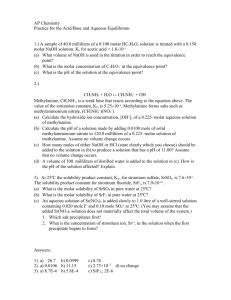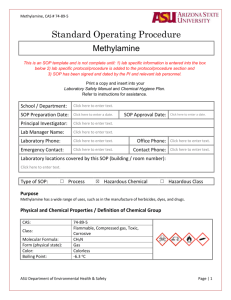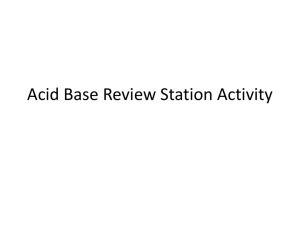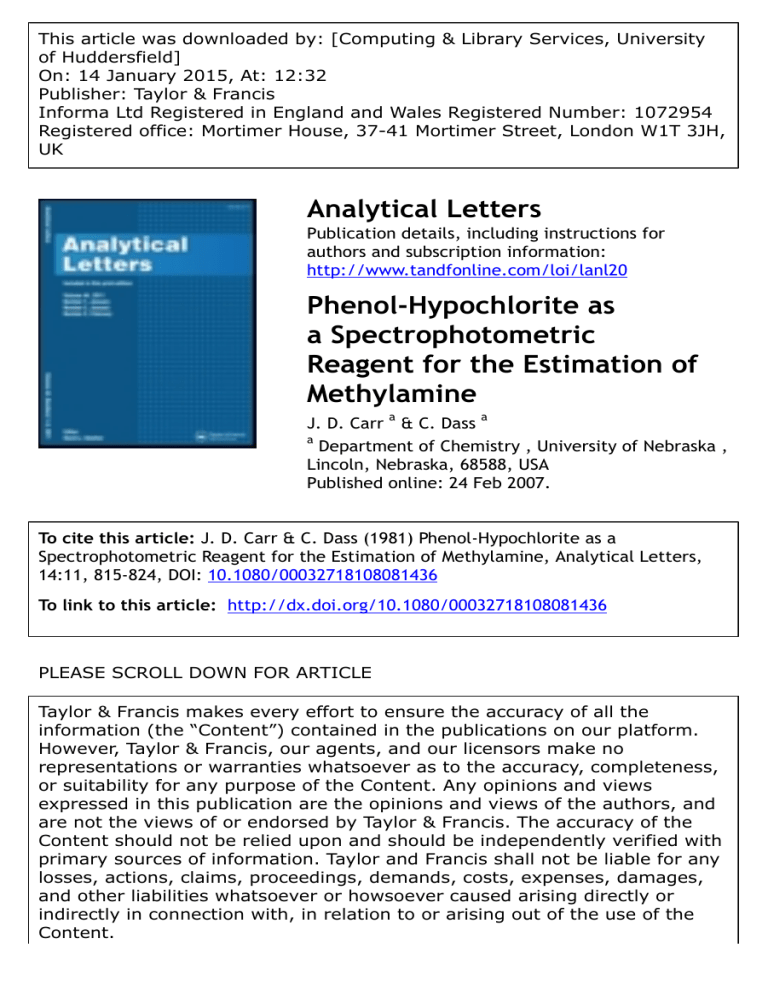
This article was downloaded by: [Computing & Library Services, University of Huddersfield] On: 14 January 2015, At: 12:32 Publisher: Taylor & Francis Informa Ltd Registered in England and Wales Registered Number: 1072954 Registered office: Mortimer House, 37-41 Mortimer Street, London W1T 3JH, UK Analytical Letters Publication details, including instructions for authors and subscription information: http://www.tandfonline.com/loi/lanl20 Phenol-Hypochlorite as a Spectrophotometric Reagent for the Estimation of Methylamine a J. D. Carr & C. Dass a a Department of Chemistry , University of Nebraska , Lincoln, Nebraska, 68588, USA Published online: 24 Feb 2007. To cite this article: J. D. Carr & C. Dass (1981) Phenol-Hypochlorite as a Spectrophotometric Reagent for the Estimation of Methylamine, Analytical Letters, 14:11, 815-824, DOI: 10.1080/00032718108081436 To link to this article: http://dx.doi.org/10.1080/00032718108081436 PLEASE SCROLL DOWN FOR ARTICLE Taylor & Francis makes every effort to ensure the accuracy of all the information (the “Content”) contained in the publications on our platform. However, Taylor & Francis, our agents, and our licensors make no representations or warranties whatsoever as to the accuracy, completeness, or suitability for any purpose of the Content. Any opinions and views expressed in this publication are the opinions and views of the authors, and are not the views of or endorsed by Taylor & Francis. The accuracy of the Content should not be relied upon and should be independently verified with primary sources of information. Taylor and Francis shall not be liable for any losses, actions, claims, proceedings, demands, costs, expenses, damages, and other liabilities whatsoever or howsoever caused arising directly or indirectly in connection with, in relation to or arising out of the use of the Content. Downloaded by [Computing & Library Services, University of Huddersfield] at 12:32 14 January 2015 This article may be used for research, teaching, and private study purposes. Any substantial or systematic reproduction, redistribution, reselling, loan, sub-licensing, systematic supply, or distribution in any form to anyone is expressly forbidden. Terms & Conditions of access and use can be found at http://www.tandfonline.com/page/terms-and-conditions ANALYTICAL LETTERS, 14(All), 815-824 (1981) Downloaded by [Computing & Library Services, University of Huddersfield] at 12:32 14 January 2015 PHENOL-HYPOCHLORITE AS A SPECTROPHOTOMETRIC REAGENT FUR THE ESTIMATION OF METHYLAMINE KEY WORDS : Methylamine, spectrophotometry,phenol,hypochlorite, sodium nitroprusside, indophenol J.D. Carr and C. Dass Department of Chemistry University of Nebraska Lincoln, Nebraska 6 8 5 8 8 , USA ABSTRACT The use of phenol and alkaline hypochlorite has been investigated for the spectrophotometric estimation of methylamine. The rea- gents react with methylamine forming an intensely blue colored dye, the maximum absorption for which is observed at 630 nm. of the reaction is slow. The rate Sodium nitroprusside is added to enhance the sensitivity and rate of the reaction. The rate is also en- hanced by raising the temperature of the reaction. The formation of the indophenol dye is pH sensitive, maximum intensity being observed at pH 10.5. The reaction mixture buffered at pH 10.5, is thermostated at 37OC and its absorbance measured at 6 3 0 nm after 3 hours. The system obeys Beer's law up to 15 ppm with slight de- viation in the lower ranges. Concentrations as l o w as 0.S ppm of methylamine can be estimated in a 1 cm cell. 815 Copyright 0 1981 by Marcel Dekker, Inc CARR AND DASS 816 INTRODUCTION The formation of indophenol dye as a resuit of reaction between ammonia, alkaline hypochlorite and phenol is a well known Downloaded by [Computing & Library Services, University of Huddersfield] at 12:32 14 January 2015 method of wide applicability for the estimation of ammonia. The method popularly known as Berthelot’ method, after its discoverer has been investigated by a number of workers. 2-5 It has been re- ported6 that volatile amines either enhance or inhibit the formation of indophenol dye. However, no attempt has been made to ex- plore the possibility of using the formation of indophenol dye as a method for the estimation of amines. Our studies have shown that a promising method can be developed using phenol and hypochlorite as spectrophotometric reagents. A blue chromophore is formed as a result of reaction between methylamine, alkaline hypochlorite and phenol catalysed by sodium nitroprusside. We have investigated various reaction variables and presented a simple method for the estimation of methylamine in 0 . 5 to 15 ppm range. EXPERIMENTAL Reagents and Apparatus: Approximately 2.5 ml of analytical grade liquid phenol was diluted to 2 5 0 ml with water. diluting 2 ml of Purex (6% Hypochlorite solution was prepared by of HOC1) to 2 5 0 ml with water. The cata- lyst was prepared by dissolving 0 . 0 2 8 g of sodium nitroprusside in 100 ml of water. A stock solution of methylamine was prepared from its 40% aqueous solution and standardized by titrating with perchloric acid. A fresh working solution of amine was prepared every day from this stock solution. All solutions were made in ammonia free deionized distilled water. The phenol, hypochlorite and stock methylamine solutions were stored in a refrigerator. Solu- tion pH was adjusted by phosphate or borate buffers and actual pH was measured against commercial standard buffers. ESTIMATION OF METHYLAMINE 817 All absorbance data were obtained on a Beckman Model 26 double beam scanning spectrophotometer using the thermostated cell. All pH measurements were made with Corning Model 12 research pH meter Downloaded by [Computing & Library Services, University of Huddersfield] at 12:32 14 January 2015 and Corning triple purpose pH electrode and calomel reference electrode. Procedure: A 4 ml portion of methylamine solution in a 2 4 ml vial is buffered to pH 10.5 by adding 5 ml of 0 . 6 M borate buffer. Five ml of sodium hypochlorite is then added and the solution shaken for complete mixing. After about one minute, 1 ml of the catalyst and 5 ml of phenol are added in quick succession. The mixture is shaken vigorously and thermostated immediately at 37OC. After about 3 hours, the absorbance is measured at 630 nm against a reagent blank treated in a similar manner. RESULTS AND DISCUSSION The absorption curve of the blue chromophore formed as a result of the reaction of methylamine with phenol and alkaline hypochlorite is depicted in Figure 1. For the sake of comparison, the absorption curve of the corresponding ammonia reaction is also included. From the similarity between the two curves, it can be con- cluded that the end product of the reaction of methylamine with phenol and alkaline hypochlorite is also a formation of an indophenol. The reaction is highly pH sensitive, as shown in Figure 1. No color was observed below pH 8 . 0 ; increased as the pH was raised. the color intensity, however, The maximum absorbance was ob- served at pH 10.5; the color intensity decreased with further increase in pH. These observations are consistent with the results of mechanistic studies of corresponding ammonia reaction by Patton and Crouch. 2 CARR AND DASS 818 Downloaded by [Computing & Library Services, University of Huddersfield] at 12:32 14 January 2015 1.o 0.8 0.2 0 450 500 550 600 650 700 750 A(=) Fig. 1: Absorption curves of indophenol formed between methylamine phenol and bypochlorite at various pH's (1) 8.10, (2) 9.00, ( 3 ) 9.80, ( 4 ) 10.20, ( 5 ) 10.55, ( 6 ) 10.89, (7) 11.70 and (8) 12.00. Curve (9) shows the absorption curve of indophenol formed with ammonia at pH 12.00. Concentrations of methylamine and ammonia are M and 2.86 X M respectively. The 2.4 X reaction temperature is 37OC. Downloaded by [Computing & Library Services, University of Huddersfield] at 12:32 14 January 2015 ESTIMATION OF METWLAMINE ua N I P v) 1 0 r 0 N \ 819 w '0 r t X 10 r v) z ' 0 X 0 P ua 0 t 0 a 0 (Y 0 r 820 CARR AND DASS The rate of formation of indophenol dye from ammonia is kinetically very slow. For this reaction to be of any significant importance for analytical purposes, sodium nitroprusside is gen- Downloaded by [Computing & Library Services, University of Huddersfield] at 12:32 14 January 2015 erally incorporated as a catalyst. The actual mechanism of its catalytical action is still uncertain, although it has been suggested that the actual species responsible for catalytical activity or aquopentacyanoferrate,2 may be sodium nitr it~pentacyanoferrate~ which are products of the alkaline solution of sodium nitroprusside. Kinetic studies of the reaction of methylamine with phenol and hypochlorite by us have revealed that this reaction is also painfully slow, and the presence of sodium nitroprusside greatly enhances the sensitivity and rate of the reaction. A linear rela- tion was observed when dA/dt was plotted against methylamine concentration as shown in Figure 2 . This relationship shows a nega- tive curvature for low concentrations at pH 10.5 which is absent at pH 11.7 although scatter is worse at pH 11.7. The rate of the chromophore formation is further enhanced by increasing the reaction temperature. However, as the temperature is raised, the final intensity of the blue chromophore decreases (Figure 3). At 25°C and pH of 10.5, it takes about 400 min for the reaction to reach the equilibrium, while the corresponding equilibrium times at 37", 4 6 O and 55°C are 180, 110 and 65 min respectively. It was also ob- served that at higher pH, the reaction is comparatively faster, but much of the advantage of comparatively shorter. time is lost with the loss in the sensitivity of the reaction at higher pH. Hence, as a compromise between the time required for the analysis and the sensitivity that can be achieved, the reaction temperature of 37" and pH 10.5 were selected as the optimum parameters for the estimation of methylamine. Once the reaction had attained equilibrium, the color intensity remained stable for a very long time. ESTIMATION OF METHYLAMINE 821 1.01 , I Downloaded by [Computing & Library Services, University of Huddersfield] at 12:32 14 January 2015 t 1 37' 0.6 0.4 0.2 0 40 80 160 120 200 240 280 TIME(mln) Fig. 3: Rate o f f o r m a t i o n of i n d o p h e n o l dye a t v a r i o u s temperat u r e s and a t pH 1 0 . 5 0 . 2.4 x C o n c e n t r a t i o n of methylamine i s M. R e a c t i o n s between methylamine and h y p o c h l q r i t e have been repr e s e n t e d by7 '' + HOC1$CH3NHC1 CH3NHC1 + HOC1$CH3NC12 CH3NH2 2CH3NHC1*CH3NCl2 + + H20 + H20 CH3NH2 C H ~ N H+~ O C ~ - & C H ~ N H C ~ + OH- (1) (2) (3) (4) 822 CARR Reactions ( 2 ) and AND DASS (3) are acid catalysed and reaction ( 4 ) takes place in basic media. Consistent with these facts, the pH dependence of the formation of the indophenol is not surprising. Downloaded by [Computing & Library Services, University of Huddersfield] at 12:32 14 January 2015 At lower pH, the stability of CH3NHCl in presence of excess HOCl decreases due to reactions ( 2 ) and ( 3 ) , and at higher pH its rate of formation is suppressed because of reaction ( 4 ) . Based upon the above facts and in accordance with the mechanism of corresponding reaction of ammonia, the following mechanism for the formation of indophenol from methylamine is proposed: CH3NHZ + OC1- catai zed 'CH3NHC1 + OH- (5) A 7 OH; 7 -0 0; "\ /"= However, this simple mechanism may not De the only process occurring. This is reflected by the fact that the precision of the method is far from satisfactory if the experimental conditions are not rigidly adhered to. Poor precision may also arise due to the deterioration in the phenol and hypochlorite solutions. For good precision, the order and timing of mixing of the solutions should be strictly followed and fresh reagent solutions should be prepared every week. The system was found to follow Beer's law up to 15 ppm of methylamine with (Figure 4 ) . As slight deviation at lower concentrations low as 0 . 5 ppm of methylamine can be estimated by the present method using 1 cm cell, however, the lower limit can be ESTTMATTOh’ OF METHYIAYINE 823 1.2 Downloaded by [Computing & Library Services, University of Huddersfield] at 12:32 14 January 2015 1 .o 0.8 w 0 z U m 5 0.6 v) m U 0.4 0.2 1.0 0 Fig. 4 : 2.0 -4 4.0~10 3.0 M plot of equilibrium absorbance vs methylamine concentration at pH 1 0 . 5 5 and 11.70. Reaction temperature is A 37’C. improved with the use of longer path length cell. Thus the indo- phenol method, which has been hitherto widely used f o r the estimation of ammonia can also be adopted f o r the estimation of methylamine with certain modifications. The method is simple and reas- onably sensitive to be of practical importance. As the rates of corresponding reactions of methylamine and ammonia with phenol and hypochlorite are quite different, a differential kinetic method can 824 CAM AND DASS be developed for their estimation in the presence of each other. Our preliminary results have not been very encouraging perhaps due to the complicated kinetics of the formation of indophenol from Downloaded by [Computing & Library Services, University of Huddersfield] at 12:32 14 January 2015 methylamine and ammonia. We, however, feel that a thorough in- vestigation of this system may result in a suitable method based on differential kinetics. Further efforts are underwil in this direction. REFERENCES 1. M. Berthelot, Repertoire de Chemie Applique, 1, 284 (1859). 2. C.J. Patton and S.R. Crouch, Anal. Chem., 49, 464 (1977). 3. W.T. Bolleter, C.J. Bushman and P.W. Tidwell, Anal. Chem., 33, 592 (1961). 4. M.W. Weatherburn, Anal. Chem., 39, 971 (1967). 5. H.B. Mark, T.E. Weichselbaum and J.C. Hagerty, Anal. Chem., 41, 848 (1969). 6. Makato Hayashi, Tsutomu Unemoto and Komei Miyaki, Chem. and Pharm. Bull ( T o k y o ) , 7 , 65 (1959). 7. J.C. Morris, “Kinetics of Reactions Between Aqueous Chlorine and Nitrogen Compounds” in “Principles and Applications of Water Chemistry”, S.D. Faust and J.V. Hunter, eds., Wiley, NY, 1964, pp. 23-53. 8. E.T. Gray, Jr., W.M. Dale and R.P. Hauffman, A.C.S. Symposium Series, No. 82, “Organometals and Organometalloids--Occurrence and Fate in Environment“, F.E. Brinckman and J.M. Bellama, eds., 1978, pp. 264-77. Received,March 13, 1981 Accepted,April 27, 1981
